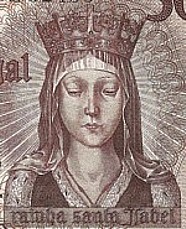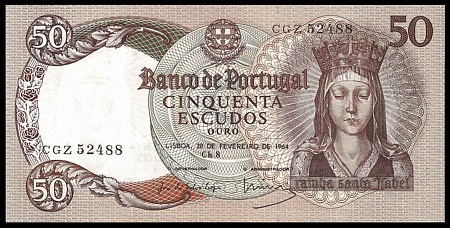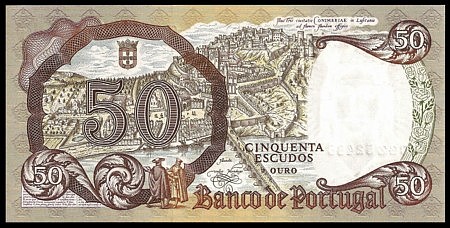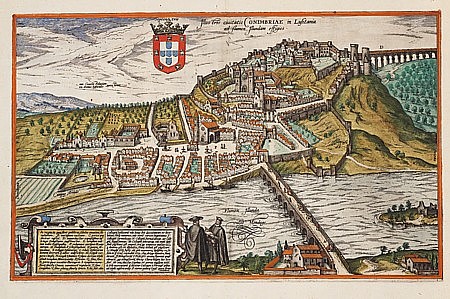PORTUGAL RAIHNA SANTA ISABEL
Raihna Santa Isabel
(Elizabeth of Portugal)

The Iberian nation of Portugal has, no doubt, created many of the world’s most attractive banknote designs and, given their prolific past, have had a large number of people and places to pluck from the history books to commemorate on their country’s money. Instead of picking only a handful to repeatedly throw up again and again, or putting whatever ruler happens to be in power at the time, the Portuguese artists, engravers and historians created a large medley of their popular history available to all those who had a bit of shopping to do while in the warm, beautiful coastal country. Until January 1st, 1999 that is, when Portugal adopted the Euro as their currency. Nevermind, there are still plenty of the older notes available to collectors.
A banknote of Portugal that has caught my eye is the 50 Escudos issued in 1964. This banknote shows a portrait of Rainha Santa Isabel, or Queen Santa Isabel, also known as Elizabeth of Aragon. She was born into the royal family of Aragon (today in Northeastern Spain) in 1271. Her mother was Constance, a Sicilian princess, and her father was at the time a prince, but would quickly ascend the throne and become King Peter III, King of Valencia and Count of Barcelona. He would later conquer Sicily in 1282, uniting his wife’s country with his own.
Even as a young child, it is said that Elizabeth was a devout Catholic, not minding the religious disciplines of attending masses and observing all the ritual practices that were required. Her piety, however, did not keep her from the rigors of royal rituals, and at the young age of 10 she was betrothed to Denis, a Portuguese prince, in an arranged marriage, which took place when she was 12. The wedding celebration, however, did not officially take place until she was 17. Perhaps because of her young age, or perhaps because of her devout piety, she was able to continue her pursuit of religious piety and took on charitable works for the poor and infirm. This modest work was unseemly for many in the court, and it did not gain her the favors of the court. That is until she seemed to convert her husband and get his life back on track with the church.
King Denis, also called the Farmer King after planting some trees to help battle some erosion, led a bit of a cavalier life, as a monarch was often wont to do in those days. He had eight children, but only tow with his wife. The other six were with at least five other women. One of those children, Alfonso Sanches, the first born, though illegitimate son seemed to be his favorite. This didn’t sit well with his first legitimate son, Alfonso IV, and a bitter rivalry ensued that lasted well into adulthood. They were about to go to war with each other, but at their mother, Elizabeth, evidently sitting upon on a donkey, rode in between the two facing armies of her son, and her husband’s illegitimate son. The facts of the deal are lost to us, but somehow Queen Elizabeth brokered a peace between them. Alfonso Sanches was sent to Castile, Spain, and Alfonso IV swore allegiance to his father.
Of her many good deeds, perhaps one of the most notable was that she would secretly take lepers into her private rooms where she would wash and change the bandages on their wounds, clothe and feed them. On one such occasion, a guard who was not aware of the queen’s secret charity, found a leper who had lagged behind. No able to believe the leper, he struck the poor wretch in the head with a stick, causing him to blead. When a servant notified the queen, she washed his head, and before bandaging it, she applied egg white to the wound. The next day, the wound was pain free and the man felt cured. Because of this act, the Portuguese Academy of Sciences made her their patron saint in 1779.
Though likely an apocryphal story, The Miracle of the Roses has been a popular belief connected with Elizabeth. In this story, she was caught by her husband as she was sneaking bread out to the poor in her apron. When he confronted her, the bread turned to a bunch of roses which, being January, was quite a shock to the king, and so he let her go on her way.
Another story is that he husband had listened to one of his court pages who told a lie concerning another page and the king’s wife having an affair. Denis was angry at hearing this and devised the death of the other page. He ordered the workers at his lime kiln to throw the first page that comes to them into the kiln.
A lime kiln is a very hot oven that burns limestone, sea shells, or coral and turns them into a very caustic substance called quicklime, which is used in tanning leather and can also be further refined to make stucco, plaster, concrete and fertilizers. The temperatures needed are around 1,600 degrees Fahrenheit, and sufficient enough to do the job of eliminating a person.
Thus ordered to on an errand to the lime kiln, the good, innocent page took an opportunity to attend the daily mass on his way, which delayed him. During this time, King Denis sent the second page to ensure the death of the other page, and so the evil page was the first to arrive at the lime kiln and to be tossed in.
Later, King Denis realized the error and that he had listened to the wrong page, and realized that the innocent page was saved by the grace of God. He begged his wife’s forgiveness and started to live a righteous life from then on.
When King Denis died in 1325, Alfonso IV, the rightful heir, took the throne and his mother retired to a monastery that she revived called the Order of the Poor Clares. At last Elizabeth was able to devote her life in full to the care of the poor and sick, which would lead to her later canonization. Her charities included caring for the sick, feeding the poor, lodging travelers, and even paying dowries for poor brides.
Elizabeth died in 1336 while once again trying to broker peace between her son Alfonso IV and, this time, King Alfonso XI of Castile, who had been mistreating his bride, the daughter of Alfonso IV, and Elizabeth’s grand-daughter. While she again stopped a battle from being waged, the efforts she endured caused her to take to bed with a fever, where she soon passed away on July 4, 1336. Her last words are reported to be a prayer to the Blessed Virgin: “From the foe shield us; in the hour of death take us.”
Her life of piety, charity and peacemaking, along with her being a well-known Queen, were undoubtedly helpful in Elizabeth’s being beatified in 1526, and later canonized by Pope Urban VIII in 1625. She is popularly shown in paintings wearing a crown like on this banknote, and often with a bunch of roses in her apron.
The back of this banknote depicts a 1598 map of Coimbra along the Mondego River, created by Georg Braun and Franz Hogenberg, Köln (Cologne), Germany.


